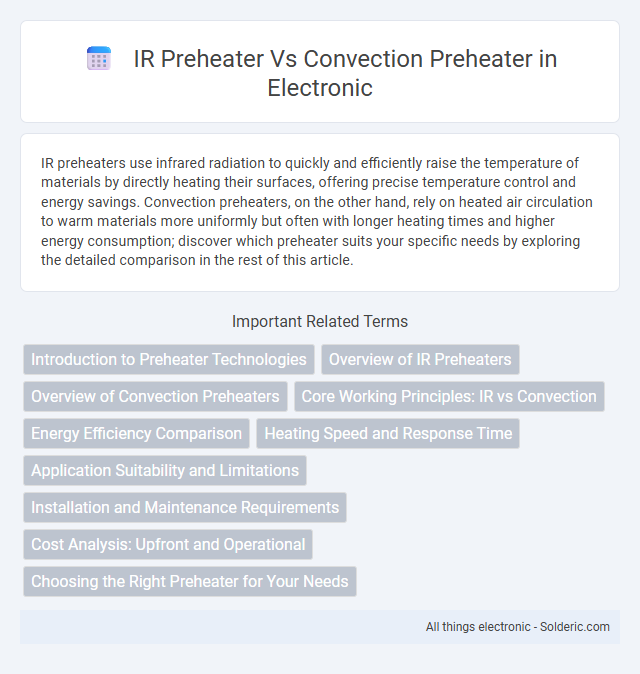IR preheaters use infrared radiation to quickly and efficiently raise the temperature of materials by directly heating their surfaces, offering precise temperature control and energy savings. Convection preheaters, on the other hand, rely on heated air circulation to warm materials more uniformly but often with longer heating times and higher energy consumption; discover which preheater suits your specific needs by exploring the detailed comparison in the rest of this article.
Comparison Table
| Feature | IR Preheater | Convection Preheater |
|---|---|---|
| Heating Method | Infrared radiation directly heats the surface | Hot air circulates to transfer heat by convection |
| Heat Transfer Efficiency | High - direct radiation ensures fast heating | Moderate - heat depends on air temperature and flow |
| Energy Consumption | Lower, due to targeted heating | Higher, due to heating of entire air volume |
| Application | Ideal for surface heating and thin materials | Better for bulk material or uniform heating |
| Heating Speed | Fast, instant heat application | Slower, depends on air heating and circulation |
| Temperature Control | Precise surface temperature control possible | Less precise due to air temperature fluctuations |
| Maintenance | Low, limited moving parts | Moderate, requires fan and air filter upkeep |
| Cost | Higher initial investment | Lower initial cost, but possibly higher operating cost |
| Environmental Impact | Energy-efficient, minimal heat loss | Higher energy loss due to air heating |
Introduction to Preheater Technologies
Infrared (IR) preheaters use radiation to directly transfer heat to the material's surface, enabling rapid and efficient heating with minimal energy loss. Convection preheaters rely on the movement of heated air or gases to transfer heat through contact, resulting in slower but more uniform temperature distribution. Choosing between IR and convection preheating depends on factors such as material properties, desired heating speed, and energy efficiency requirements.
Overview of IR Preheaters
IR preheaters utilize infrared radiation to directly heat materials, offering rapid and uniform surface heating compared to convection preheaters, which rely on heated air circulation. You benefit from increased energy efficiency and faster processing times with IR preheaters, especially in applications requiring precise temperature control. Their design reduces heat loss and enhances product quality by minimizing thermal gradients.
Overview of Convection Preheaters
Convection preheaters use hot air or flue gases to transfer heat to materials, making them highly efficient for large-scale industrial processes where uniform heating is crucial. Your choice depends on the required temperature control and energy efficiency, as convection preheaters excel in consistent heat distribution over infrared preheaters. These systems are widely applied in cement kilns and thermal processing industries for optimal material preheating.
Core Working Principles: IR vs Convection
IR preheaters operate by emitting infrared radiation that directly heats the material's surface through electromagnetic waves, enabling rapid and uniform heating without relying on air circulation. Convection preheaters transfer heat via a heated air stream that surrounds the material, relying on convection currents to raise the temperature gradually through direct contact with hot air. The fundamental difference lies in IR using radiant energy for surface heating, while convection depends on fluid movement for thermal energy transfer.
Energy Efficiency Comparison
Infrared (IR) preheaters offer superior energy efficiency by directly heating the material surface with minimal heat loss, unlike convection preheaters that rely on heating surrounding air, resulting in greater energy consumption. IR preheaters enable rapid temperature rise and precise control, reducing overall energy use and operational costs. Your choice of IR preheater can significantly enhance energy savings compared to conventional convection systems.
Heating Speed and Response Time
IR preheaters offer significantly faster heating speed and shorter response time compared to convection preheaters due to direct infrared radiation that rapidly raises the temperature of the target surface. Convection preheaters rely on heated air circulation, resulting in slower heat transfer and delayed temperature response. The efficiency of IR preheaters makes them ideal for applications requiring precise and immediate thermal control.
Application Suitability and Limitations
Infrared (IR) preheaters offer precise, rapid heating ideal for small-scale or targeted preheating applications, such as in electronics or polymer processing, but are limited by shallow penetration and uneven heating on bulky materials. Convection preheaters excel in uniformly heating larger volumes or complex shapes, making them suitable for automotive and aerospace industries, though they require longer heating times and consume more energy. Selecting between IR and convection preheaters depends on the thermal conductivity, size, and geometry of the workpiece, as well as energy efficiency and process speed requirements.
Installation and Maintenance Requirements
IR preheaters require precise alignment and specific placement to ensure effective infrared radiation exposure, often demanding skilled installation and careful calibration. Maintenance of IR preheaters involves regular cleaning of infrared emitters and periodic replacement of bulbs or elements to maintain optimal performance. Convection preheaters typically have simpler installation processes with fewer alignment constraints but require routine inspection and cleaning of filters and fans to prevent overheating and ensure efficient airflow.
Cost Analysis: Upfront and Operational
Infrared (IR) preheaters generally have a higher upfront cost due to advanced technology and specialized materials, while convection preheaters tend to be less expensive initially because of simpler designs. Operational costs for IR preheaters are often lower thanks to faster heating times and greater energy efficiency, reducing overall energy consumption. Convection preheaters typically incur higher operational costs due to longer heating cycles and greater heat loss, impacting energy bills over time.
Choosing the Right Preheater for Your Needs
Selecting the right preheater depends on your specific process requirements and energy efficiency goals. IR preheaters use infrared radiation for rapid surface heating, ideal for materials sensitive to oxidation or requiring precise temperature control. Convection preheaters circulate hot air, delivering uniform heat distribution suited for bulk drying or applications needing steady airflow; your choice hinges on the material type, desired heating speed, and overall operational efficiency.
IR preheater vs convection preheater Infographic

 solderic.com
solderic.com